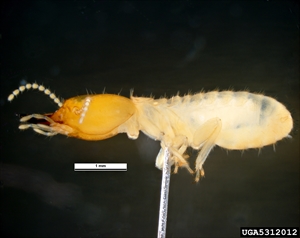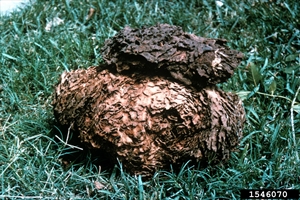- Widespread. Asia, Africa (South Africa), North America (including Hawaii), the Caribbean (US Virgin Islands), Oceania. In Marshall Islands.
- Serious invasive pest. Large colonises and damage happens quickly. Attacks on living trees and buildings cause loss of native diversity, a need for expensive treatments, and increased pesticide use.
- Colonies contain kings and queens (sexually mature males and females), i.e., ‘reproductives’ (winged, yellow-brown bodies, golden-brown heads, 12-15 mm); soldiers (whitish, 4-5 mm long, orange-brown oval heads - exude defensive glue-like fluid, pincer-like mouthparts); workers (whitish, collect cellulose, build nests, feed larvae).
- Reproductives swarm briefly, females lay eggs in moist holes or crevices, and care for them. Later, more eggs and workers take over. Colony expands, many millions, then 5-7 years later reproductives swarm again. Usual food is living and dead trees; more recently, towns and cities invaded and feeding includes building timbers.
- Spread with wooden cargoes on ships (pallets, telephone poles, rail sleepers, soil, and more).
- Biosecurity: listed by IUCN among 100 of World's Worst Invasive Species. National legislation and awareness is needed to prevent its introduction or further spread.
- Cultural control: restrict movement of wood, plants, soil in infested areas; inspect homes and trees regularly; where practical, allow sunshine into buildings, and free flow of fresh air; practice good hygiene in and around homes; clean drains avoid lingering puddles, and repair any leaks.
- Chemical control: apply building codes to prevent termite infestations; apply toxic insecticides as barriers beneath buildings; use baits (chiton synthesis inhibitors) in monitoring stations around buildings.










